The Asian hornet is only getting hungry for fresh bees and larvae in high-summer. And that is now.
( Also check our update on our Asian hornet traps, here)
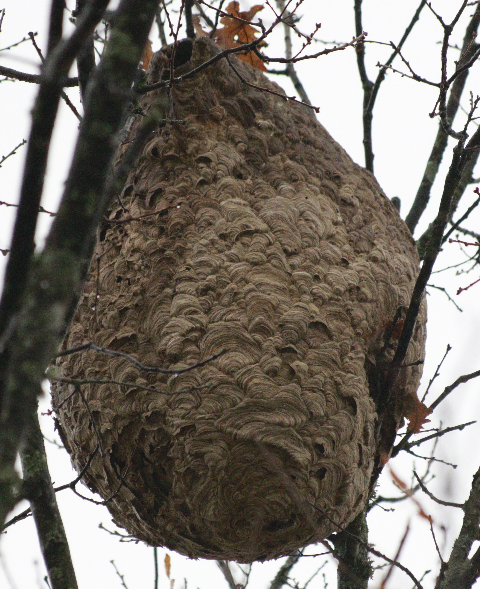
Little groups of hornets hang in front of the hive and attack the honey bees that want to fly in and out. If the bee population has lost a lot of bees, the hornets can enter the hive and eat the larvae as well.
The Asian hornet, Latin name:
How to protect the honey bees against the Asian hornet?
• Immediately report the location if you have seen a hornet nest. In Portugal you can do this on a special portal: www.stopvespa.pt and a pdf with instructions on how to report them.
We had some difficulty reporting observations through this portal; you can also pass it on to the town hall or the local beekeeping association. All member states of the European Union are obliged to combat the Asian hornet. So after reporting, the nest will be destroyed during the night with a telescopic flame thrower.

• Here in Portugal, some beekeepers protect their bee colonies against the hornet with an electric fence, which they call harp. The bees fly through it, but the hornet is wider, touches the wires and is then electrocuted.
• In addition, you can keep the opening of the hives small so the hornet cannot enter. You can also make a wired basket around the opening; honey bees can get to the hive opening, but the hornets cannot.
• Do not paint your hive boxes yellow, yellow attracts hornets. (This doesn’t help 100%, because the mainly orientate on their sense of smell, which is very strong. )
• Start having chickens and let them roam freely around the hives. Chickens are good hornet catchers, especially chickens of the Janzé breed seem to be very good at it.
• Put some hornet traps up. Especially in the early spring, when chances are high for killing the hibernated queens. They will no longer be able to start a nest that will later produce hundreds of hornets. After spring it still worths using traps, to lure the hornets away from the hives and reduce the number of bees they kill.
It will probably help when you paint the traps yellow to attract the hornets more.
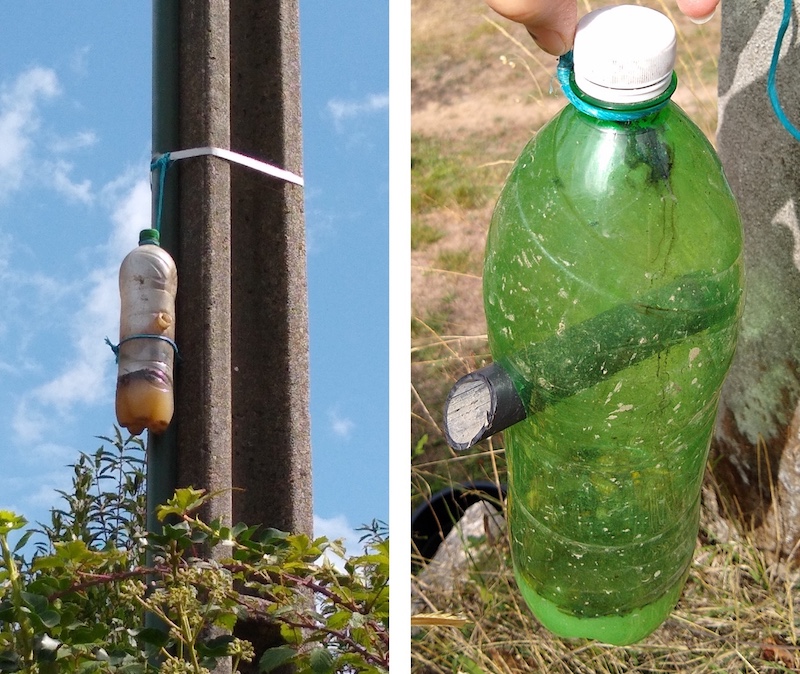
Making a hornet trap
As I wrote in a previous post, we received a number of traps from Mónica, the local beekeeper adviser. They are very simple to make. You only need two plastic bottles, a piece of iron wire, a stapler, a pair of scissors, a knife and a drill and 10
And this bate goes in the hornet trap:
From February to June you can fill the hornet trap with apple juice or with the following cocktail:
– 1 liter of white wine
– 0.5 liters of beer
– 0.2 grenadine syrup
– a shot of spirits
From July to September you use this cocktail:
– 1 liter of water
– 200 grams of sugar
– 12 grams of baker’s yeast (dry)
Update Sept 2020: Quite frankly, we are not impressed by the number of hornets we catch with the summer cocktail. It seems to take a few days before the hornets are drawn to it. But in the meantime, you have already caught a lot of moths and flies with it.
One of our readers said he had more success with meat. We hardly eat that. I tried it with some minced beef, but it didn’t work well either.
Yesterday I saw an alternative on youtube; mix a little water with 3 tablespoons of honey. The trap was completely full in 1 day. I will try that now. In the meantime, we are also beating the hornets to death with our homemade hornet-smacker:
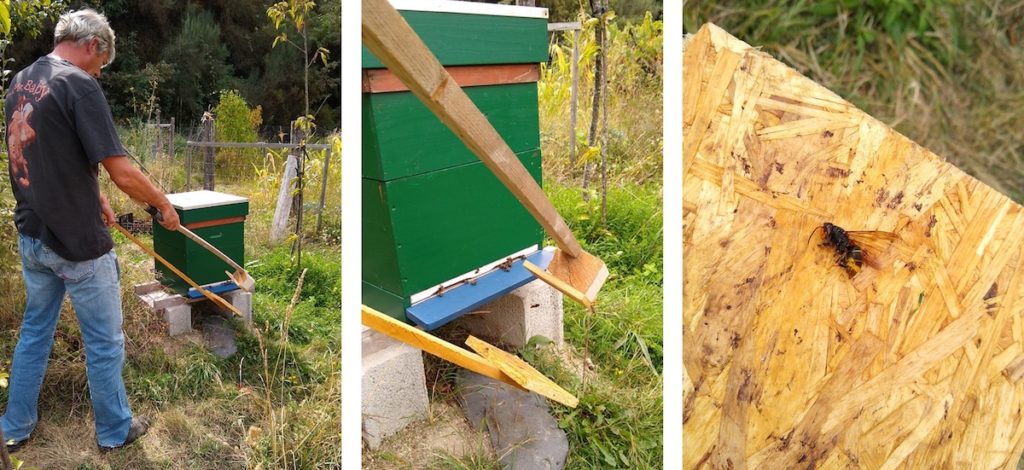
Useful Portuguese words:
| Asian hornet | Vespa Velutina/ Vespa Asiática |
| to kill | matar |
| nest | ninho |
| queen | rainha |
| to destroy | destruir |
| yellow | amarela |
| trap | armadilha |
| grenadine syrup | groselha |
| beer | cerveja |
| white wine | vinho branco |
| apple juice | sumo de maçã |
| sugar | açucar |
| baker’s yeast | fermento padeiro |
July 30, 2019

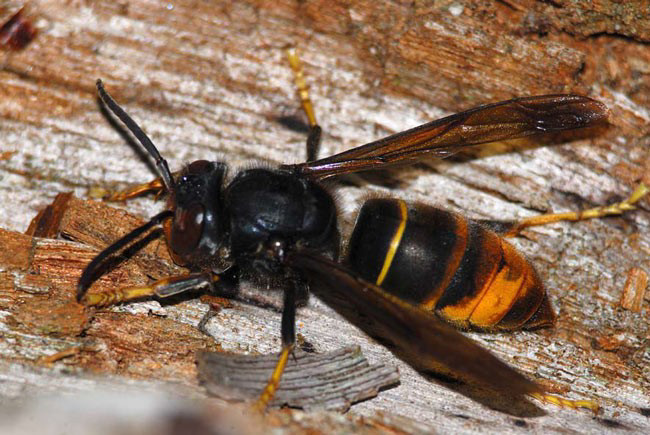

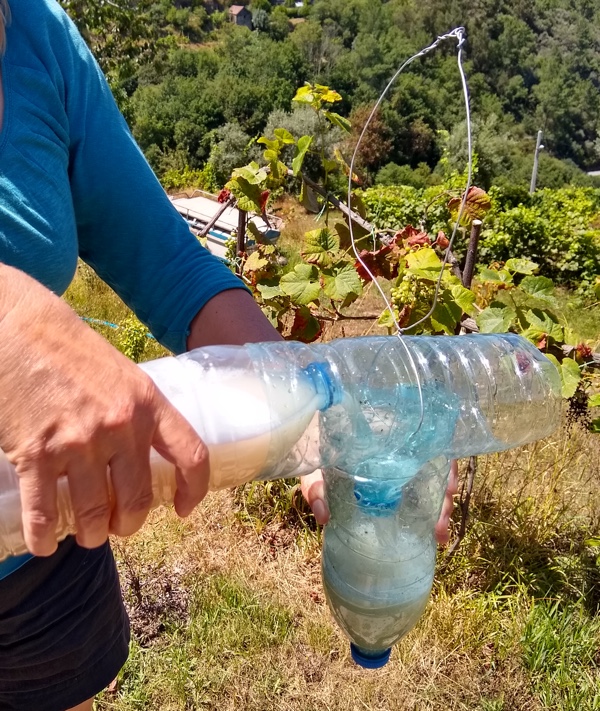
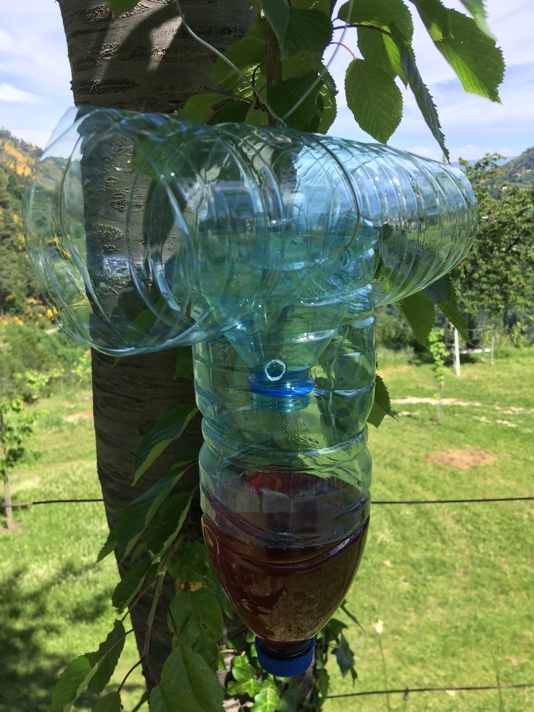
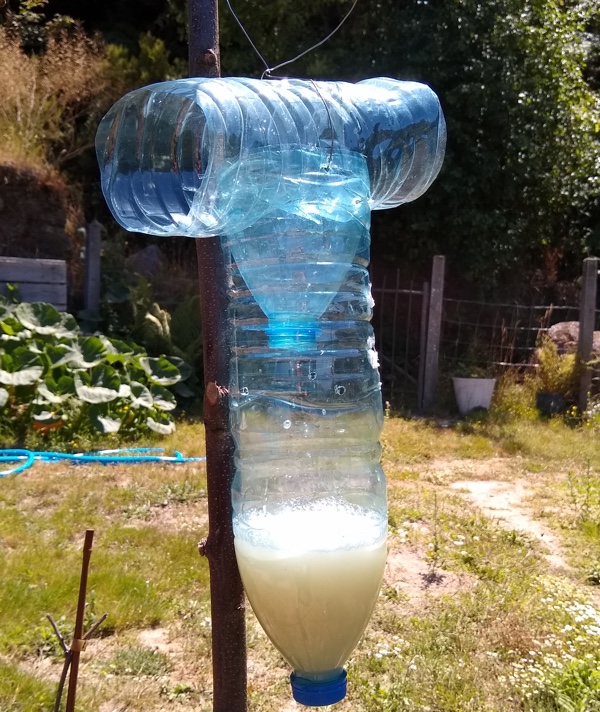
Sorry, There’s a mistake, the word Queen : Rainha.
Thanks for the useful information about this belutina.
Oops! A typo, thanks for letting us know. Changed it immediately
Hi.
I have 3 hives and the Asian wasp discover them.
I placed several traps and captured a few.
I don’t know where the nest is.
There are 3 big trees close but I can’t look threw the leaves if the nest is there.
How can I get help deeling with them?
I placed meet in two traps and sugar, yiest and water in two more. I catched 3 Asian wasp on the meet trap, none on the yiest…
How can I report it, the link is not working.
I am close to celorico da Beira in guarda district.
Hi Shay,
Thanks for your comment. I am afraid I can’t help you. The vespas are not attracted to the yeast at the moment, we have the same problem.
Are the vespas in the hives? Then i would advise to narrow the entrances.
Sorry the link doesn’t work. I’ll check that tonight.
As you can see in our latest bee post, we are smacking the hornets one by one… https://www.asrolhas.com/en/beekeeping-portugal-4/
hi Dona.
thank you.
the vespas are hovering outside the entrance, i will narrow the openings…
as i understand, the yeast will work on the quins just before winter. right?
I am not sure about the best time to put yeast in the traps.
Our neighbour is now also making traps with yeast, sugar and water. But I am not impressed by the amount of vespas he catches. The bee-specialists advise to use it now though…
Have you already seen those electric harps, they sell to kill the vespas? Here is an example (i didn’t watch the whole video myself) to give you an idea. I am not convinced if it works well.
https://www.youtube.com/watch?v=gaAtDH6FwNw
To conclude: It is very difficult to find the nests of the vespas, you said that you suspect they are in the trees near your land, but that doesn’t necessarily has to be. Vespas can also have the nest in the old terrace walls, or in the ground. You can not report when you see the hornets, you can only report a nest.
thanks…
do you know where can i buy this fence?
btw, i catch them in a trap with meet as bait..
Hi Shay,
Probably at the local beekeepers association office ( i gave you the link the other day).
Or try olx.pt. Since we don’t live close to you, I wouldn’t know this in your area.
You have to find the nest. We know that if you set up a bait, attract the hornets and mark a couple using a beekeeping marking pen and a queen catcher. Release back onto the bait. The hornet needs to fly from the bait to the nest and then back again. For every minute that the hornet is away, the nest is about 100m away. It does not hold true for the low flight times. When the hornet returns at about 1 min, the nest is about 25m away. Through this method, triangulation and following the flight line you find the nest.
That’s an interesting trick, Alastair. Thanks for sharing!
Did you find some nests this way?
I have located a wasp nest near my home – in a tree and the size of a basketball. It must be murder hornets because I have killed over 150 of them near my bee hive. Who do I call? It is in a tree in my neighbor’s garden here in Sintra
Hi John, I thought sosvespa.pt, but i see this website is dead.
I found this on the internet:
A deteção ou a suspeita de existência de ninho ou de exemplares de vespa asiática deverão ser comunicadas através ou do contacto com a GNR, ou através da linha SOS Ambiente e Território (808 200 520).
I think when you call to your local police or bombeiros station, they will be able to help you too.
Boa sorte!
One of our readers gave his ultimate recipe and method for catching hornets in Dutch, this is his translated comment :
Dear friends beekeepers,
I use a 5-litre plastic bottle; I cut off the head and place it back on the bottle upside down (without the screw cap, of course), so that it becomes a kind of funnel. I fill the bottle with one glass of white wine, one glass of blonde beer and one glass of white granulated sugar. Mix it up and put it in a good place on the floor. Easy because 5-litre bottles stand firm and don’t fall over easily, even in a thunderstorm.
Three traps were set. After ten days (mid-August 2022), I had caught more than 300 hornets, 45% of which were Asian hornets. Refresh regularly, especially after rainfall. Hornets need sugar as fuel to fly, they rob bees which serve as food for their larvae in the nest.
The hornet queens come out (after their hibernation , in early March) to set up their nests (1st and 2nd).
From June through September, the hornet workers are massively active, by mid-October the workers are all dead and have raised as many as several dozen new queens with one nest.
These new queen hornets start looking for any burrow to hibernate in from October to the end of November. That is, these queens need sugar to fly/search and hibernate.
So set up the traps already in early March to the end of November. The Hornets you catch in the months of March April May and in autumn October, November are 80% all queens. And one captured queen hornet equals 2,000 worker hornets.
Good luck.
Ronn
Registered Beekeeper (Indre – France).
March 2022 I went all out setting traps for Founder hornets, for every mated queen I caught, knowing it would eventually produce a few 1000 offspring, I was amazed at how may I trapped. That year we had a remarkably reduced number of hornets attacking our hives. 2023 I did not do the same, to my detrement I lost over 30 hives, admittedly some were veroa related deaths. Ultimately the wasp, reducing your colony numbers, keeping them locked in the hives and afraid to go out to forage, reduces the overall strength and eventually they collapse.